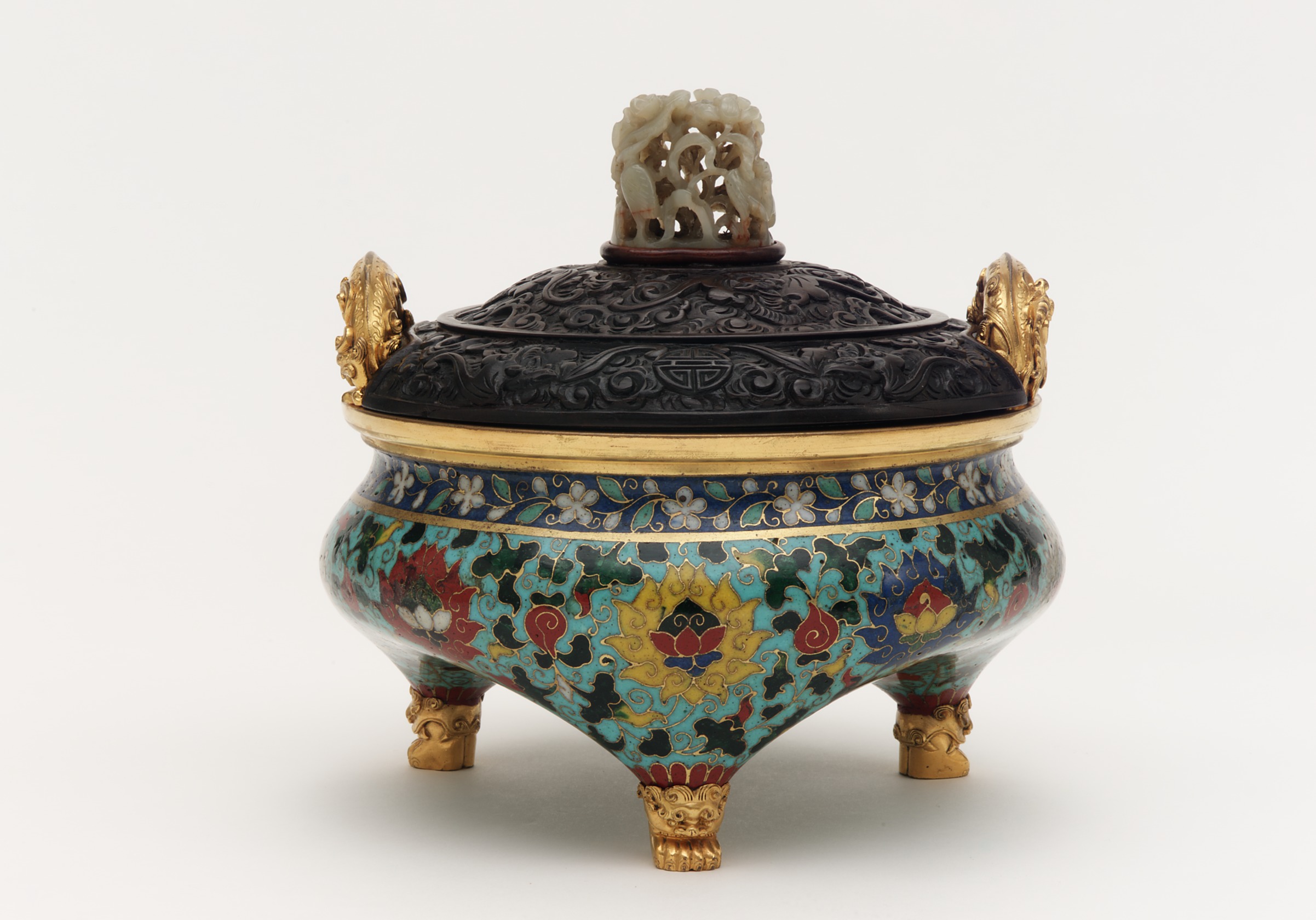This decorated metal vessela container such as a cup, bowl, pot, or dish. was made to be used as an incensea material created from spices, flowers, and other natural elements that release scents (smells) when burned. burner. It has a bellied shape with three short, pointed legs. Nine colorful floral and leaf designs lie on a beautiful turquoise background on the main body of the vessel. These lotus flowers are the primary decorations on the incense burner. They are in vibrant colors of red, white, blue, green, yellow, and dark purple, and they are surrounded by scrolling leaf patterns. Above this main design is a narrow, dark blue band with white plum blossoms. The underside of the vessel has three symbolsshapes or designs that are recognizable and have a meaning associated with them of luck: a peach for immortalitythe ability to live forever., a pomegranate for numerous heirs, and an orange for good fortune. The vessel was created in the technique called cloisonné(cloy-zuhn-ay) a decorative method that uses small metal wires to outline shapes/designs on a piece of metal. The shapes (cloisons) are then filled with enamel that, when fired in a kiln or heated to a very high temperature, turns into a glass-like medium and creates bright and opaque areas of color.. The wooden cover was removed when burning incense, as no sign of smoke is found on the lid.
Cloisonné(cloy-zuhn-ay) a decorative method that uses small metal wires to outline shapes/designs on a piece of metal. The shapes (cloisons) are then filled with enamel that, when fired in a kiln or heated to a very high temperature, turns into a glass-like medium and creates bright and opaque areas of color. is a technique for decorating metal. Making cloisonné is exacting, time-consuming and expensive. A craftsman first outlines a design on the metal surface, then bends thin wires into shapes to follow the lines, and finally solders them in place. Then, the specialist fills the wire enclosures, or cloisons, with colored glass paste and fires the object. The glass paste, or enamelan opaque (dark) paste that is used to add color to hard surfaces like metal. It turns into a glass-like texture, which also provides protection, when heat is applied., shrinks when firedthe act of heating pottery in a kiln.. Usually, four or five rounds of adding enamel and re-firing are required to finish an object. At the end, the exposed wires are gilded.
One theory is that cloisonné was introduced to China during the Yuan(yoo-en) dynastya series of rulers from a single family. (1279–1368) brought by the well-traveled Mongol invaders. It was a fully developed craft in China by the early fifteenth century when the rich and vibrant color effects it could produce suited imperialrelating to an empire, an emperor, or the home of royals. taste. This incensea material created from spices, flowers, and other natural elements that release scents (smells) when burned. burner is of such high quality that it was likely produced for the Ming court.
The incensea material created from spices, flowers, and other natural elements that release scents (smells) when burned. burner is in the tripod li(lee) shape: a squat rounded body supported on three short legs. It is based on li bronzea mixture of copper, tin, and often lead that produces a strong metal. vessels used during the Shang(shahng) (ca. 1600–ca. 1050 BCE) and Zhou(joe) (ca. 1050–221 BCE) dynasties for offerings of food at rituala set pattern of behavior for a religious or other kind of ceremony. ceremonies. In later China, the function changed to an incense burner. This type of vessela container such as a cup, bowl, pot, or dish. became very popular during the Ming (1368-1644) and Qing(ching) (1644–1911) dynasties and was used for burning incense during rituals, including ancestorsomeone from whom you are descended. In Western thought, it is usually more distant than a grandparent; however, in Chinese culture, deceased parents and grandparents are considered ancestors. worship ceremonies. The smoke from incense was used as a link between the earthly realm and the heavenly world.
- Look carefully at this object. Make a list of ten possible things you think it may have been used for. What visual evidence can you find to support your theories?
- In what context would incensea material created from spices, flowers, and other natural elements that release scents (smells) when burned. have been used in Ming dynastya series of rulers from a single family. China? In what contexts is it used today? How do special scents add to a special occasion or environment? Why has incense been valued across different times and cultures?
- Research what types of incense were used in Ming dynasty China and where this incense came from.






